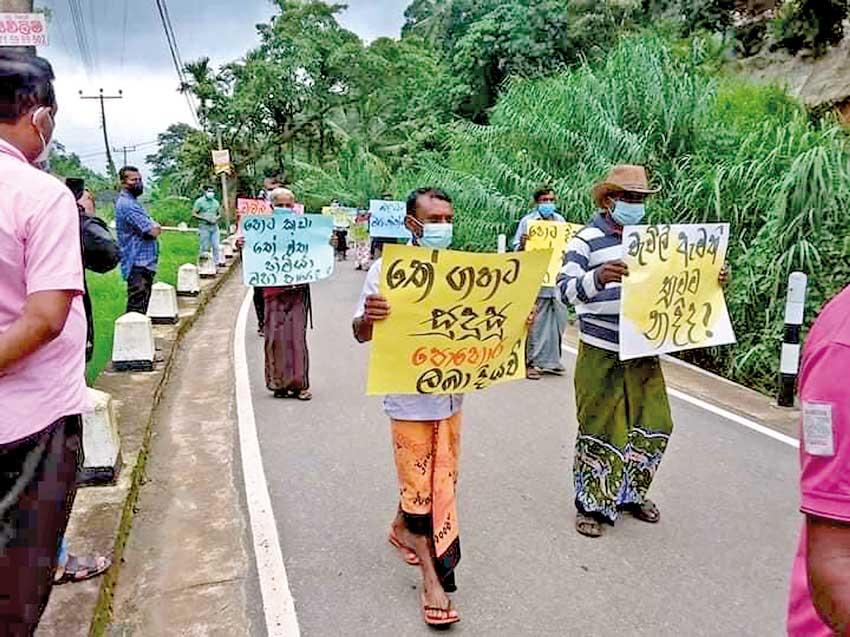15 Jul 2021 - {{hitsCtrl.values.hits}}

With the islandwide shortage of fertilisers and dealers opting to sell fertilisers at black market prices many tea planters including tea smallholders in the Southern region took to the streets
Many tea planters explained why compost fertiliser will not give an expected yield when compared to chemical fertiliser
Tea growers expect profits, but they won’t be able to experience profits given this situation
Tea estates are on mountainous lands and the run-off will end up in rivers and streams
 The government’s move to ban chemical fertilisers has taken a heavy toll on many agriculture-related sectors including the tea industry. At the onset of the decision many tea planters explained why compost fertilisers will not give an expected yield when compared to chemical fertilisers. With the islandwide shortage of fertilisers and dealers opting to sell fertilisers at black market prices, many tea planters including tea smallholders in the Southern region took to streets. Protests were staged at Yatadola, Matugama, Urubokka and several other areas.
The government’s move to ban chemical fertilisers has taken a heavy toll on many agriculture-related sectors including the tea industry. At the onset of the decision many tea planters explained why compost fertilisers will not give an expected yield when compared to chemical fertilisers. With the islandwide shortage of fertilisers and dealers opting to sell fertilisers at black market prices, many tea planters including tea smallholders in the Southern region took to streets. Protests were staged at Yatadola, Matugama, Urubokka and several other areas.
If this decision is implemented around 500,000 tea planters scattered in around eight districts will have to look for alternative methods of income. Another 300,000 people work as laborers. The market for Ceylon Tea will die a natural death
Ad hoc decisions and repercussions
“With the immediate move to ban chemical fertilisers those who had plans to invest in the plantation sector is now in a dilemma,” opined Low Country Tea Planters Association Secretary S. M. P Jayantha. “Usually plants for the following year are prepared the previous year and those doing nurseries are now stuck without a proper direction. Those who were expecting to plant will not be able to do so. Tea growers expect profits, but they won’t be able to experience profits given this situation. The government could have planned this process in two years, so that those in different agriculture sectors could have been better prepared for it.
Fertiliser stocks available till September-Aluthgamage
However, when contacted, Minister of Agriculture Mahindananda Aluthgamage said that the Minister of Plantation Industries has requested for 53,000 metric tonnes of fertiliser. “This has already been allocated and until September we have no issue about fertilisers. There are stocks in warehouses but farmers are on the streets. So it’s very clear as to who is behind these protests.” said Minister Aluthgamage.
|
“The tea industry was properly managed during the first COVID wave in March 2020,” he added. “Government policies were successfully implemented and factories were functioning under health guidelines. The Government even made plans to have an e-auction for tea buyers. Therefore one kilo of green leaves (raw) was priced at Rs. 120. People also started investing in 30-40% bare lands during this time and they started growing tea. The Government also introduced nursery schemes for 50,000 plants and 100,000 plants. Following the drought that struck last year a subsidy scheme was introduced. As such Rs. 25 lakhs per hectare was allocated for replanting funded by ADB low interest rate loan scheme and by 2021 April the plantations were back to their former glory” he said.
It was at a time like this that the Government made plans to ban chemical fertilisers and agrochemicals without consulting the Sri Lanka Tea Board, Tea Research Institute or without consulting any stakeholders including Regional plantation companies, tea small holders from the tea industry.
According to Tea Research Institute recommendations in order to get a potential yield of 2000-2500 kilograms per hectare per year (kg/ha/yr) in the up country region the recommended quantity of Nitrogen, Phosphorus and Potassium is 270, 35, 120 respectively. For a yield of above 3500 kg/ha/yr 400 kilos of nitrogen is required. For the low country region in order to get a potential yield of 2000-2500 kg/ha/yr the recommended quantity of Nitrogen, Phosphorus and Potassium is 270, 35 and 100. For a yield of above 3500 kg/ha/yr 400 kilos of nitrogen is required.
“The nitrogen percentage in chemical fertilisers is between 25-30%. But when it comes to compost fertilisers the nitrogen percentage is as low as 2%. Therefore if estates are to move in to using compost fertilisers the requirement would be between 30,000-40,000 kilos. This means more labourers are required when its time to add fertilisers to crops. Right now a labourer gets around Rs. 1150 as a daily income. But if compost fertilisers are being used the cost of planting would increase by about 300%. Tea planters will not be able to bear this cost,” said Jayantha.
Compost fertilisers will not give the same yield as chemical fertilisers. Therefore crop yield is likely to reduce by 30-40%.
Explaining further about the fertiliser subsidy, Jayantha said that between 2000-2006 the cost of crude oil increased from $30-$160. “Therefore the market price of urea also increased. As a result, the cost of fertiliser increased to Rs. 5000 and the then government promised to give fertilisers at a subsidized rate of Rs. 1000.
Initially we used to get fertilisers from Middle Eastern countries such as Libya but later on we got low quality, low cost fertilisers from countries such as China. After some time we received complains from farmers saying that the fertilisers are not up to standard. Then farmers were blamed for overusing fertilisers. The National Fertilizer Secretariat is responsible for checking the standards of fertilisers before distributing them to the market. These fertilisers end up in rivers and people have various health conditions when heavy metals get added to water. Therefore before blaming farmers the authorities should do their duty first.
“Fertilisers are added every three months but due to low quality and low price farmers started adding it every two months,” he continued.
Speaking about compost fertilisers, he further said that the solid needs to be amended. “Tea estates are on mountainous lands and the run-off will end up in rivers and streams. We do not know what sort of bacteria, fungi etc are in these fertilisers. We need to implement soil conservation methods. Already there are methods using leaf manure but these processes will have to be expedited in a large scale. We will need around 180,000 metric tonnes of overall fertilisers. People talk about cow dung etc., but have we advanced our agriculture to implement integrated farming concepts? After all farmers have a democratic right to choose whichever fertiliser they want for their crops.
“On the other hand there are full time and part time tea planters. Part time tea planters want an additional income and they too will be affected by this decision,” he added.
Jayantha further said that if this decision is implemented around 500,000 tea planters scattered in around eight districts will have to look for alternative methods of income. “Another 300,000 people work as labourers. The market for Ceylon Tea will die a natural death as it will be replaced by other competitive orthodox tea brands in the international market.” he affirmed.
26 Nov 2024 3 hours ago
26 Nov 2024 4 hours ago
26 Nov 2024 5 hours ago
26 Nov 2024 6 hours ago
26 Nov 2024 6 hours ago